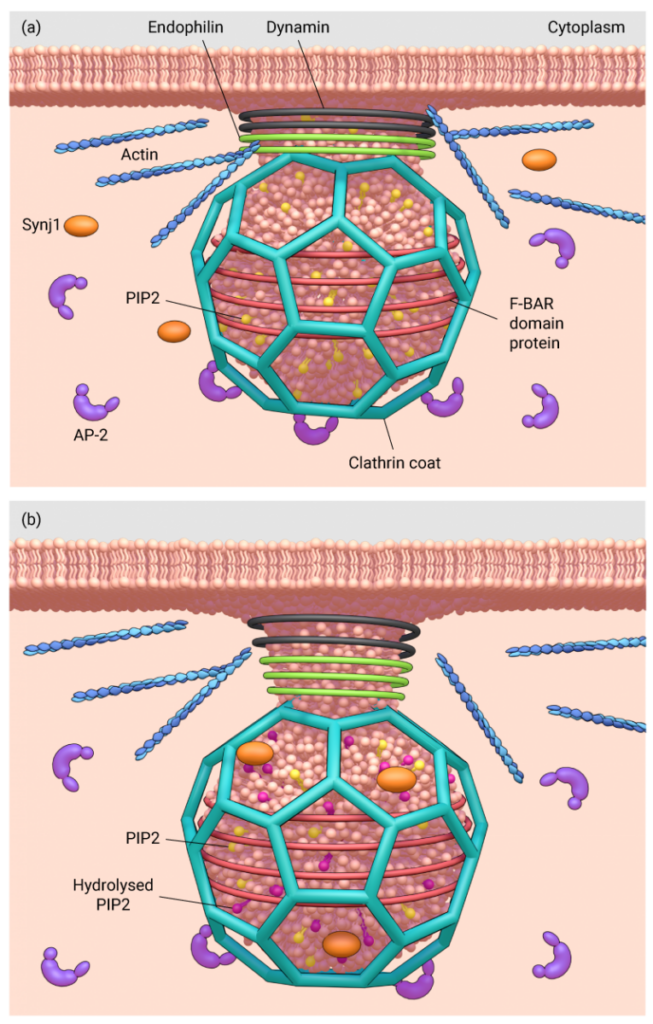How does the clathrin-coated vesicle neck narrow?
In the final stages of clathrin-coated vesicle (CCV) formation, Phosphatidylinositol-4,5-bisphosphate (PIP2) undergoes a dephosphorylation by phosphatases such as synaptojanin 1 (Synj1) [1]. Not only does this inhibit PIP2’s signal transduction capabilities and ensures that the adaptor proteins selectively accumulate within the plasma membrane, but it also promotes further membrane curvature at the vesicle bud, dissociation of the BAR domain proteins (BDPs) and closing of the membrane bud neck [1].
Synj1 has been shown to be recruited by endophilin 1 [1] [2], a BDP that arrives at the endocytic site later than other adaptor proteins [3]. Through its partnership with endophilin, which possesses a curve-sensing role, Synj1 may preferentially hydrolyze PIP2 in highly curved membranes [4].

(a) In the final stages of CCV formation, phosphatases such as Synj1 is recruited by endophilin, and (b) PIP2 is preferentially hydrolysed, which leads to further increases in membrane curvature and narrowing of the endocytic bud neck
Normally PIP2 is protected from hydrolysis by the BDPs. With increasing membrane curvature however, the binding strength of the BDPs is weakened, exposing more membrane (and hence PIP2) to the phosphatases. This positive feedback loop promotes continued dephosphorylation of PIP2, and leads to further increases in membrane curvature and subsequently a narrowing of the endocytic bud neck [1].
Current evidence suggests that membrane curvature enhances phosphatase function by providing greater access to the lipid head groups for both increased binding and hydrolysis activity [5]. This is indeed the case with phospholipase-c activity [6], and it has also been confirmed using cell cell-free assays with liposomes of varying sizes that Synj1 possesses an intrinsic preference for smaller vesicles with highly curved membranes [4].
References
- Gad H, Ringstad N, Löw P, Kjaerulff O, Gustafsson J, Wenk M, Di Paolo G, Nemoto Y, Crun J, Ellisman MH, De Camilli P, Shupliakov O, and Brodin L. Fission and uncoating of synaptic clathrin-coated vesicles are perturbed by disruption of interactions with the SH3 domain of endophilin. Neuron 2000; 27(2):301-12. [PMID: 10985350]
- Schuske KR, Richmond JE, Matthies DS, Davis WS, Runz S, Rube DA, van der Bliek AM, and Jorgensen EM. Endophilin is required for synaptic vesicle endocytosis by localizing synaptojanin. Neuron 2003; 40(4):749-62. [PMID: 14622579]
- Perera RM, Zoncu R, Lucast L, De Camilli P, and Toomre D. Two synaptojanin 1 isoforms are recruited to clathrin-coated pits at different stages. Proc. Natl. Acad. Sci. U.S.A. 2006; 103(51):19332-7. [PMID: 17158794]
- Chang-Ileto B, Frere SG, Chan RB, Voronov SV, Roux A, and Di Paolo G. Synaptojanin 1-mediated PI(4,5)P2 hydrolysis is modulated by membrane curvature and facilitates membrane fission. Dev. Cell 2011; 20(2):206-18. [PMID: 21316588]
- Liu J, Sun Y, Drubin DG, and Oster GF. The mechanochemistry of endocytosis. PLoS Biol. 2009; 7(9):e1000204. [PMID: 19787029]
- Ahyayauch H, Villar AV, Alonso A, and Goñi FM. Modulation of PI-specific phospholipase C by membrane curvature and molecular order. Biochemistry 2005; 44(34):11592-600. [PMID: 16114896]


